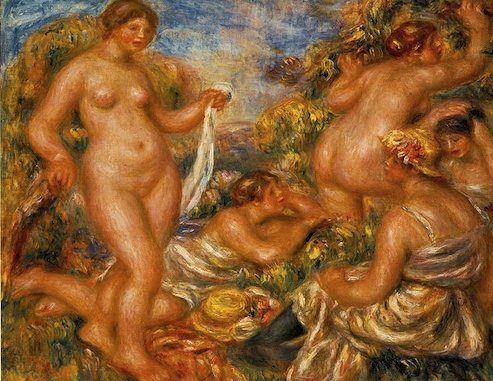
The Barnes Foundation in Philadelphia houses a stunning art collection that covers many periods and genres but has a solid backbone of French modernism. Dr Barnes built the collection after making a fortune from medicine and was influenced by two main sources, both of which delighted in the creativity on show in Paris in the early 1900s. Barnes’ friend the painter William Glackens purchased work to start the collection and set his eye to France, but Leo Stein’s views also influenced the direction of Barnes’ collecting. The two men had met on one of Barnes’ collecting trips to Paris and the artists that Stein loved also became targets for Barnes chequebook. Indeed, he bought his earliest Matisse directly from the art critic. The Barnes has the world’s largest collection of another artist Stein championed, holding 181 different paintings by Renoir. These are spread throughout the museum and there are so many that if you are in doubt who painted a picture you are looking it – you’re probably looking at a Renoir worth millions.

Barnes dealt directly with Matisse to commission a work to fill the lunettes in the gallery at Merion. Although Matisse worked on The Dance in France he used life-size templates of the unusually shaped space. These he put on the walls of a local garage as they were too big for his studio. He drew with charcoal attached to sticks to give him freedom and force him to ignore detail, a method he would use to great success when decorating the chapel at Vence. The finished work is a free-form expression of buoyant enthusiasm, painted in the style of his later cut-outs using flat expanses of colours and a restricted palette. The artist was pleased with the result, claiming that thanks to it, ‘the whole ceiling and the arched vaults come alive.’

Barnes has relatively few Monets, of which one shows an investigation of the effects of light on water as might be expected from the great Impressionist. The other is an image of his wife embroidering, which is an interesting departure from his usual subject-matter. An indoor scene is a rarity in Monet’s oeuvre, though Camille appears to be sitting in a conservatory and the large windows mean Monet has not left his favourite subject far behind. Here the light is damp, grey and Parisian and is not the theme of the picture, which is the placing of Madame Monet in the old pictorial tradition of industrious women showing their devotion through needlework.

Amongst several Cezannes that Barnes purchased is a still-life with skull, a subject that had been typical for painters for centuries. Cezanne positions the cloth so that he might as well be painting his beloved Mont Sainte-Victoire. As always Cezanne finds the architectural structure within his subject, imbuing the fruit with a substantiality and grandeur rarely seen in a pear.

Barnes also purchased work by French artists of an earlier generation. Courbet is represented by The woman with white stockings. This dates from a period in Courbet’s work when he seemed to court notoriety. Seen as explicit in its time it was not exhibited for decades. The model’s wistful expression as she dresses conveys something of the confusion that surrounds human relationships. Whilst not seen, the recently-departed lover is a huge presence in the work.
When you are in a gallery with 181 Renoirs it is easy to become blasé as you walk past another Renoir. And another Renoir. Female nudes were his favourite subject, but he also painted landscapes.

Noirmoutier is an island off the Nantes coast. Now it is connected to the mainland by a road but in 1892 Renoir had to take a boat. He praised the landscape but found the journey too far. Landscapes such as this allowed Renoir to paint with a darker palette and explore wilder themes of loneliness. But Renoir has not been able to completely leave the female behind and has painted two women in the very centre of the painting. He even interprets the trees and branches in a sensual, feminine manner. The landscape emits a sense of foreboding and if not unhappiness then at least ennui and makes the viewer think that Renoir was happier with a model in the studio with the city around and a cafe next door.
This is just a brief introduction to some of the more unusual French paintings in the Barnes Foundation. If yo uare interested in seeing more then visit the website for more information.

Leave a Reply